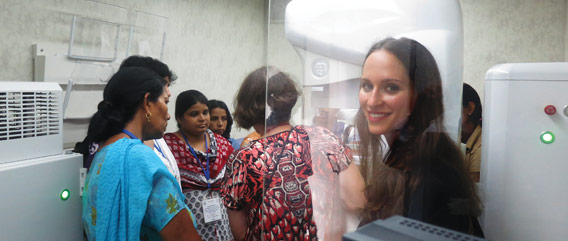Rays of Hope
Anna Starikovsky Nordvig was an up-and-coming associate in the Goldman Sachs global banking group when a devastating ski injury early in 2009 sparked an interest that would evolve into a new career. “I was struck by how thin a sliver of the world I actually understood,” says Mrs. Nordvig, now a second-year medical student at P&S. “I had a craving to comprehend what had happened to my own body—to heal others as I’d been healed.”
Even as she signed up for volunteer shifts in a Manhattan emergency department to test her budding interest and applied for a postbaccalaureate degree at Columbia, Mrs. Nordvig continued with her day job and used her corporate network to search for mentors.
Among the connections she forged, Daniel Mollura, MD, a fellow Goldman Sachs alumnus who had graduated from Columbia’s postbaccalaureate program a decade earlier, would prove to be a kindred spirit. “It’s a pretty frightening leap and she and I connected through that commonality,” says Dr. Mollura, now deputy director for the Center for Infectious Disease Imaging at the NIH Clinical Center. They also found a shared passion for international health care. Dr. Mollura was in the early stages of founding an all-volunteer nonprofit called RAD-AID to promote access to radiological medicine in developing countries and invited Mrs. Nordvig to join the organization.
Now RAD-AID’s vice president of organizational strategy, Mrs. Nordvig began building RAD-AID’s India Program in 2010, deploying a radiology-readiness survey she helped develop soon after joining the organization. “We talked about it as a feasibility study,” says Dr. Mollura. “In the engineering world, you always go check out the site, understand the natural and human resources. We wanted to do the same with RAD-AID.”
For assistance, Mrs. Nordvig recruited three aspiring Columbia MBAs to travel with her on one of her missions to India. “My approach was to treat it like a business—apply the organizational strategy that I had learned in my business career to a proposal that would really knock the socks off of donors—demonstrate that we thought through continuity of care and local sustainability.”
The result was Asha Jyoti, a three-way partnership among RAD-AID, Royal Philips Electronics (Philips Healthcare), and a public, government-run hospital in the capital city of Punjab. The pilot program was launched in April 2012. In its first six months, Asha Jyoti—the name means “ray of hope” in Hindi and Punjabi—screened 600 women for cervical and breast cancers and osteoporosis in a specially outfitted clinic van and built awareness for women’s health throughout the state. The program also trained 32 female mammogram technologists.
At its annual meeting in September 2012, the Clinton Global Initiative featured the project during the plenary session. “Anna has created a unique partnership structure among government, nonprofit, and private industry, and she negotiated for about a year and a half to get that done,” says Dr. Mollura. “It had to be done in parallel with designing the new mobile clinic. That’s an amazing form of multi-tasking, to spend a year and a half negotiating three partners at the same time and designing a program on an innovative piece of hardware. She’s a very talented leader and Asha Jyoti is a manifestation of that quality.”
- Log in to post comments


